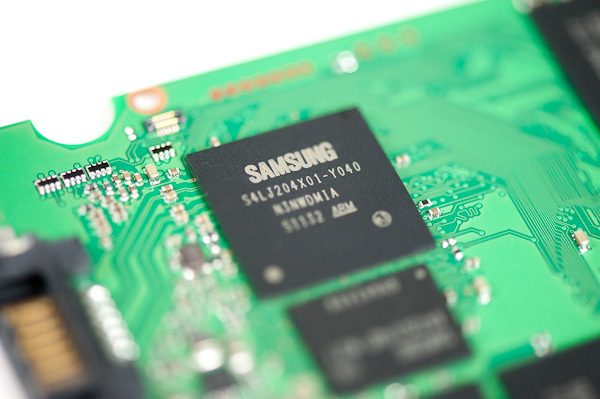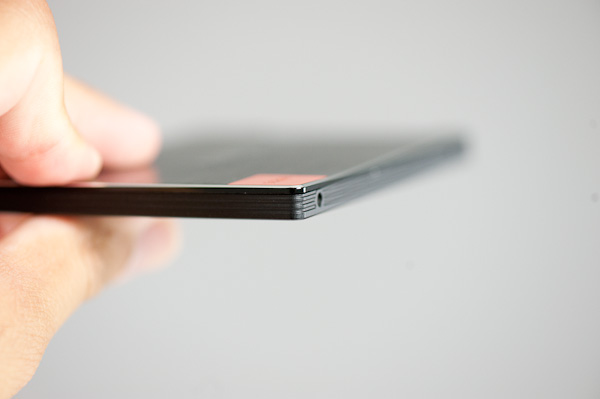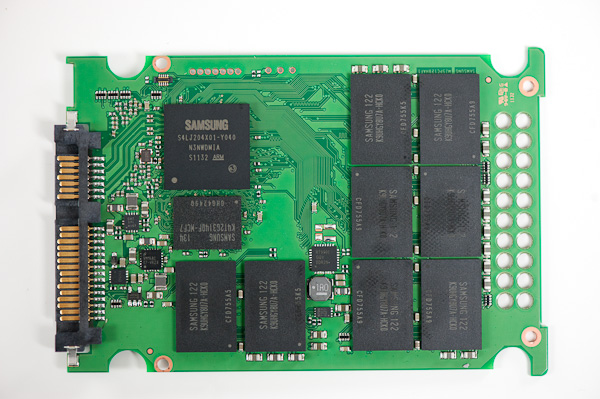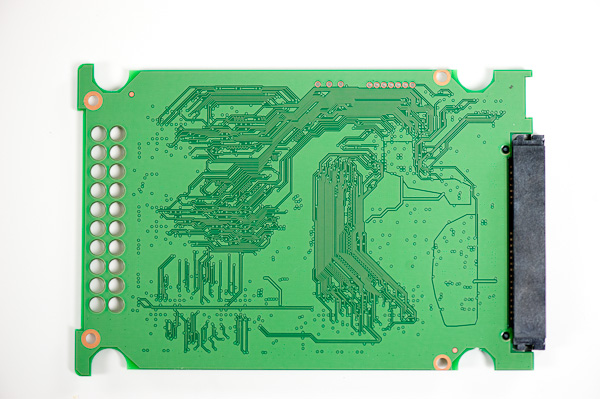The Samsung SSD 830 Review
by Anand Lal Shimpi on September 24, 2011 1:02 AM EST- Posted in
- SSDs
- Storage
- Samsung
- pm830
- Samsung SSD 830
Samsung is a dangerous competitor in the SSD space. Not only does it make its own controller, DRAM and NAND, but it also has an incredible track record in terms of reliability. Samsung SSDs were among the first I reviewed and while they weren't anywhere near the fastest back then, every last one of those drives is still working without issue in my lab today. It's also worth pointing out that Samsung SSDs are also one of the two options Apple rebrands and delivers in its Mac lineup. To continue to hold on to Apple's business for this long is an impressive feat on Samsung's part.
In the early days Samsung actually sold reference designs to companies like Corsair and OCZ. Its partners could then rebrand and resell the drives, which they did. Samsung was still learning the market and after being overshadowed by Indilinx in the performance segment, Samsung retreated. Returning last year to the consumer market Samsung had a new strategy in mind: go directly after the channel. Seeing no point in reselling its designs to third parties, Samsung made its SSD 470 available to both OEMs and consumers alike. OEMs were free to obscure the Samsung name but consumers were told upfront what they were getting. Samsung even spent a good amount on packaging for their drive just to develop its brand.
Although the 470 was a downright decent 3Gbps drive, it was competing in a world dominated by 6Gbps alternatives. Crucial's m4, Intel's SSD 510 and OCZ's Vertex 3 all offered better performance, at a similar price point. The only leg Samsung had to stand on was reliability, which believe it or not can sometimes take second place to performance depending on the target market. What Samsung needed was a faster drive that didn't sacrifice reliability and didn't move price points up. That's exactly what the Samsung SSD 830 is designed to do.
As we've already mentioned, the 830 is an evolution of the 470 design. It still employs a page-mapped architecture to deliver high random and sequential performance, but as a result requires quite a bit of on-board memory. Samsung has no qualms about storing user data in DRAM temporarily so it outfits the SSD 830 with a massive 256MB DDR2 cache. While this cache was spread over two chips in the 470, it is contained in a single package in the 830.
On the interface side Samsung gave the 830 a much needed upgrade to 6Gbps SATA. With a higher speed interface to the host controller and some tweaks on the firmware side Samsung is able to deliver much higher performance than the outgoing 470. Samsung manufactures and uses its own 2x-nm Toggle-mode DDR NAND which is fairly similar in performance to the ONFi 2.x NAND used by Intel and Crucial (133Mbps data rates per interface).
Little is known about the 830's controller other than it is a multi-core ARM design. Samsung claims the controller has three cores however we don't have any information on the design of each core nor the type of work each one does. As SandForce has claimed in the past, SSDs are rarely limited by processing power. Instead it's the firmware, algorithms and internal chip memories that ultimately determine performance. Samsung has claimed in the past its multi-core design yields better performance under multitasking workloads but I'm guessing that's more marketing than substantive.
The enterprise version of the 830 enables full-disk encryption (AES-256) however Samsung's product literature doesn't clarify whether or not the same is true for the consumer version.
The Drive
The SSD 830 is the consumer version of Samsung's recently announced PM830. The two drives use identical hardware but they do differ in initial firmware revisions. Samsung will provide firmware updates (Windows only) via its Magician Software. Users are also able to configure the amount of spare area on the drive using the Magician toolbox. By default spare area is set at a standard ~7% (just what you get from the GB to GiB conversion), putting the 830 on par with Intel and Crucial in that regard.
The Samsung SSD 830 will be available to consumers starting in mid October. Although Samsung isn't announcing pricing at this time, I've been told to expect the drive to be priced around where the SSD 470 is today. I popped over to Newegg to do a quick price check on the 470 and came away relatively pleased:
| Newegg Price Comparison | |||||
| 256GB | 128GB | 64GB | |||
| Samsung SSD 470 | $384.99 | $214.99 | $114.99 | ||
| Crucial m4 | $379.99 | $196.99 | $94.99 | ||
| Intel SSD 510 | $569.49 | $279.99 | |||
| OCZ Vertex 3 | $439.99 | $209.99 | $134.99 | ||
For the most part the SSD 470 is priced competitively with the Crucial m4 and OCZ Vertex 3. Crucial is a bit cheaper across the board but the gap is at most $20. If Samsung can keep its 830 pricing on par with where the 470 is today, I'll have absolutely no complaints.
The 830 will be available in four capacities, each of which will be available in three different versions: bare drive, laptop installation kit and desktop installation kit. The bare drive will be the cheapest option while the laptop kit gives you Norton Ghost + a SATA to USB cable and the desktop kit gives you Norton Ghost + a 2.5" to 3.5" adapter (with SATA cable).
| Samsung SSD 830 Lineup | |||||||
| 512GB | 256GB | 128GB | 64GB | ||||
| NAND Type | 2x-nm Toggle MLC | 2x-nm Toggle MLC | 2x-nm Toggle MLC | 2x-nm Toggle MLC | |||
| NAND | 512GB | 256GB | 128GB | 64GB | |||
| User Capacity | 476GiB | 238GiB | 119GiB | 59GiB | |||
| Random Read Performance | Up to 80K IOPS | Up to 80K IOPS | Up to 80K IOPS | Up to 75K IOPS | |||
| Random Write Performance | Up to 36K IOPS | Up to 36K IOPS | Up to 30K IOPS | Up to 16K IOPS | |||
| Sequential Read Performance | Up to 520 MB/s | Up to 520 MB/s | Up to 520 MB/s | Up to 520 MB/s | |||
| Sequential Write Performance | Up to 400 MB/s | Up to 400 MB/s | Up to 320 MB/s | Up to 160 MB/s | |||
Samsung sent us a 512GB drive, however as you can see from the table above the performance should be identical to the 256GB version. We are trying to get our hands on lower capacity versions as well to see how they perform.
The 830 is a very pretty drive, something Samsung is quite proud of. The 7mm chassis is all plastic save for the aluminum top plate. The bare drive doesn't ship with an adaptor for 9.5mm bays. If your notebook requires a 9.5mm drive you'll need a carrier of some sort to make the drive fit. There are no screws on the 830, the top plate just snaps on/off:
Inside the 512GB drive are only 8 NAND packages occupying one side of the PCB. These are octal-die packages with 64GB of total NAND per package. Each die is obviously 8GB in capacity.
The Test
| CPU |
Intel Core i7 2600K running at 3.4GHz (Turbo & EIST Disabled) - for AT SB 2011, AS SSD & ATTO |
| Motherboard: |
Intel DH67BL Motherboard |
| Chipset: |
Intel H67 |
| Chipset Drivers: |
Intel 9.1.1.1015 + Intel RST 10.2 |
| Memory: | Corsair Vengeance DDR3-1333 2 x 2GB (7-7-7-20) |
| Video Card: | eVGA GeForce GTX 285 |
| Video Drivers: | NVIDIA ForceWare 190.38 64-bit |
| Desktop Resolution: | 1920 x 1200 |
| OS: | Windows 7 x64 |















99 Comments
View All Comments
ruzveh - Wednesday, September 28, 2011 - link
hey anand, where are the other tests dude? Where is the boot time test, application open time, app loading time, etc.???abufrejoval - Wednesday, September 28, 2011 - link
This gap between ZEUS and FusionIO, SLC and embedded SAN SSDs on one end and those consumer SSDs on the other end has been narrowing, but it's incredible to see just how much vendors from all over the place fight to keep it from closing.I got enterprise workloads, which aren't all that high, very predictible, with highs and lows in line with typical OLTP front-end shopping patterns as well as some end-of-day processing.
The crux is the need for ultra high availability (or extremely short outages) and KISS answers that better than investing into premium SANs.
I want directly attached SSDs there, preferably in 2.5" form factor and in RAIDs for better capacity management and non-stop replacements.
20,ooo IOPS should do just fine, the real key is reliability and easy non-stop management. Daily overwrite is well below capacity so consumer SSDs should be fine. And I wouldn't mind replacing them after two years, if they'll reliably advise me of their imminent death weeks ahead.
I tried being clever and put Crucial m3 and OCZ Vertex 2 in a mirror set with an SSD aware LSI SAS RAID controller, to offset the risk of immature firmware/controller issues (the original plan was to use a SAN/SSD mirror, but resilvering would be too expensive). That didn't work out too well, because of these garbage collection issues (m3 drives were failed by the RAID controller, just because they took a little longer than their OCZ counterparts).
Of course we used synthetic tests first, "fio" to be exact and that just keeps those drives busy, busy, busy, quite beyond what actual workloads are likely to be. And in those cases the difference in garbage collection strategy caused real clashes, because the Crucial m3 took a finally took a long break when it had exhausted it's free space, while the OCZ stayed ready always, doing garbage collection on each and every write.
In real life, we might never see that problem, because actual IOPS during early mornings (after the day-end processing) might drop below the "magic" threshold" which allows those Crucials to do their garbage collection, but who knows what would happing during Christmas shopping season, when those unknown thresholds might just be exceeded a wee bit...
SSDs are not magnetic hard disks: They contain operating systems that need to be tuned just like your typical Oracle database. What's missing is interfaces which allow to read and set these well defined and published parameters in line with the use case you requrie.
In purely technological terms that should be easy enough. But every vendor, from database, via OS and SSD will want his cut for this reliability and speed, which is why this may not happen for another couple of years.
If only Samsung could make this strategy decision (early or late garbage collection) a user defined setting without price differentiation (enterprise vs. consumer) I'd be so happy!
Why do I think it won't happen?
gixxer - Monday, October 10, 2011 - link
Does anyone have a more concrete release date than "october"? I am starting a new build and if this gets released soo, it will definitly be a contender.DanSmith - Tuesday, December 6, 2011 - link
Hi Anand / All,Wonder if you if could shed any light on this drive supporting AES encryption using the "ATA password" BIOS options. Its been months now and this drive is on the market and there is sooo much conflicting info on the web about this drive supporting AES.
Even samsung themselves can give me a straight answer!!
Anyone who has one of these that can shed any light??
Cheers, Daniel
valhar2000 - Monday, December 26, 2011 - link
What's a TRIM pass? Do you have to run some sort of procedure every now and then to apply TRIM to an SSD? Isn't TRIM supposed to work in real time as files are deleted or moved?kazumoda - Wednesday, February 8, 2012 - link
I've been searching for a place to buy this Samsung PM830 but all I can find is the AM830. Can someone tell me if this is essentially the same thing or is it a vastly different product in terms of performance and reliability? Thanks. Is there any update on the performance of a smaller drive, in particular how does the 256gb version fare in terms of performance to the 512?datalaforge - Monday, February 27, 2012 - link
I recently installed one of these into my 2.26GHZ Unibody MBP. Its great with its 10 second boots and so on. The battery life is not great though. I think that it was better before. Is there anything that can be done?BRKHD1 - Sunday, September 30, 2012 - link
great review I love your site! I recently did a speed test of the samsung 830 on my youtube channel you can check it out here https://www.youtube.com/watch?v=gZJ-pPeE5lA Thanks again!BRKHD1 - Wednesday, November 28, 2012 - link
http://www.youtube.com/watch?v=gZJ-pPeE5lA&fea...